
Hanover is a town in Plymouth County, Massachusetts, United States. The population was 14,833 at the 2020 census.

The Park–McCullough Historic Governor's Mansion is one of the best-preserved Victorian mansions in New England. It is a thirty-five room mansion, set on 200 acres of grounds, and located off Vermont Route 67A in North Bennington, Vermont, USA.
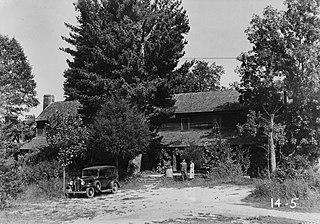
Travelers Rest State Historic Site is a state-run historic site near Toccoa, Georgia. Its centerpiece is Traveler's Rest, an early tavern and inn. It was designated a National Historic Landmark on January 29, 1964, for its architecture as a well-preserved 19th-century tavern, and for its role in the early settlement of northeastern Georgia by European Americans.

Glen Eyrie is an English Tudor-style castle built in 1871 by General William Jackson Palmer, the founder of Colorado Springs. There are 17 guest rooms in the castle, as well as 7 meeting rooms including the Castle Great Hall and 2 dining rooms. This house was his and his wife's dream home, and is near Colorado Springs in the northwest foothills just north of the Garden of the Gods rock formations. After building a large carriage house where the family lived for a time, Palmer and his wife Mary "Queen" Mellen built a 22-room frame house on the 800-acre (3.2 km2) estate. This house was remodeled in 1881 to include a tower and additional rooms, and made to resemble a stone castle in 1903, reminiscent of those native to England.

Orchard House is a historic house museum in Concord, Massachusetts, United States, opened to the public on May 27, 1912. It was the longtime home of Amos Bronson Alcott (1799–1888) and his family, including his daughter Louisa May Alcott (1832–1888), who wrote and set her novel Little Women (1868–69) there.
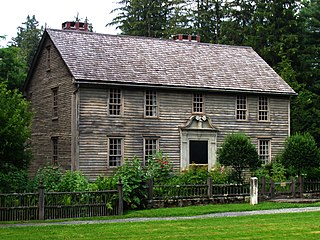
The Mission House is an historic house located at 19 Main Street, Stockbridge, Massachusetts. It was built between 1741 and 1742 by a Christian missionary to the local Mahicans. It is a National Historic Landmark, designated in 1968 as a rare surviving example of a colonial mission house. It is now owned and operated as a nonprofit museum by the Trustees of Reservations.
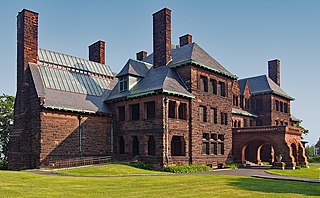
The James J. Hill House in Saint Paul, Minnesota, United States, was built by railroad magnate James J. Hill. The house, completed in 1891, is near the eastern end of Summit Avenue near the Cathedral of Saint Paul. The house, for its time, was very large and was the "showcase of St. Paul" until James J. Hill's death in 1916. It is listed as a U.S. National Historic Landmark, operated by the Minnesota Historical Society. It is also a contributing property to the Historic Hill District.

Castle Hill is a 56,881 sq ft (5,284.4 m2) Tudor Revival mansion in Ipswich, Massachusetts built 1926-1928 as a summer home for Mr. and Mrs. Richard Teller Crane, Jr. It is also the name of the 165-acre (67 ha) drumlin surrounded by sea and salt marsh the home was built atop. Both are part of the 2,100-acre (850 ha) Crane Estate located on Argilla Road. The estate includes a historic mansion, 21 outbuildings, and landscapes overlooking Ipswich Bay, on the seacoast off Route 1, north of Boston. Its name derives from a promontory in Ipswich, Suffolk, England, from which many early Massachusetts Bay Colony settlers immigrated.

The Searles Castle is a French chateau-style castle-style house in Great Barrington, Massachusetts. Built in the 1880s, the romantically imagined structure has seven stories and includes a "dungeon" basement. The castle was initially designed by Stanford White of McKim, Mead and White, a famous New York architectural firm at the time. There are 40 rooms containing 54,246 square feet (5,039.6 m2) of floor space, as well as 36 fireplaces.

Carlyle House is a historic mansion in Alexandria, Virginia, United States, built by Scottish merchant John Carlylefromn 1751 to 1752 in the Georgian style.
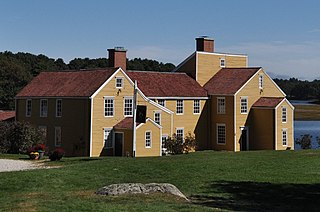
Wentworth–Coolidge Mansion is a 40-room clapboard house which was built as the home, offices and working farm of colonial Governor Benning Wentworth of New Hampshire. It is located on the water at 375 Little Harbor Road, about two miles southeast of the center of Portsmouth. It is one of the few royal governors' residences to survive almost unchanged. The site is a New Hampshire state park, declared a National Historic Landmark in 1968. Today, the New Hampshire Bureau of Historic Sites manages the site with the assistance of the Wentworth-Coolidge Commission, a group of volunteer civic and business leaders appointed by the Governor.

The David Whitney House is a historic mansion located at 4421 Woodward Avenue in Midtown Detroit, Michigan. The building was constructed during the 1890s as a private residence. It was restored in 1986 and is now a restaurant. The building was listed on the National Register of Historic Places in 1972.

The Wythe House is a historic house on the Palace Green in Colonial Williamsburg, in Williamsburg, Virginia, USA. Built in the 1750s, it was the home of George Wythe, signer of the Declaration of Independence and father of American jurisprudence. The property was declared a National Historic Landmark on April 15, 1970.

The Apex Union Depot is a historic railroad station located on Salem Street in downtown Apex, North Carolina and is the centerpiece of the Apex Historic District. Constructed in 1914 by the Seaboard Air Line Railroad, the building shared service with the Durham and Southern Railway, but now houses the Apex Visitor's Center, Apex Chamber of Commerce, and meeting rooms rented out for special events. A 37-foot Louisville and Nashville Railroad caboose is located beside the building. In December 1998 the Apex Union Depot was listed on the National Register of Historic Places.

The General Benjamin Lincoln House is a National Historic Landmark at 181 North Street in Hingham, Massachusetts, United States. It was the birthplace and principal residence of Continental Army Major General Benjamin Lincoln (1733–1810), a well-respected military leader of the American Revolutionary War. The house has portions that are said to date to the 1630s, with significant additions made principally during the 18th century, possibly making it one of the nation's oldest wood-frame buildings. The last major modifications to the house were probably undertaken by General Lincoln in the late 18th century.

The Endicott Estate is a mansion built in the early twentieth century, located at 656 East Street in Dedham, Massachusetts “situated on a 15-acre panorama of lush green lawn that is punctuated by stately elm, spruce and weeping willow trees.” It was built by Henry Bradford Endicott, founder of the Endicott Johnson Corporation, and donated to the Town by his adopted stepdaughter, Katherine. After she died it was briefly owned by the state and intended to be used as the official residence of the governor, but was quickly returned to the Town. Today it is used for a variety of civic events and is rented out for private parties.
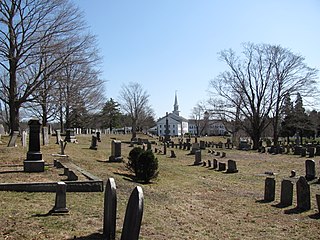
The Hanover Center Historic District encompasses the historic town center of Hanover, Massachusetts. Established in 1721, the town center includes the town hall, library, and church, as well as its first cemetery and the c. 1700 Stetson House, one of its oldest buildings. The district was listed on the National Register of Historic Places in 1996.
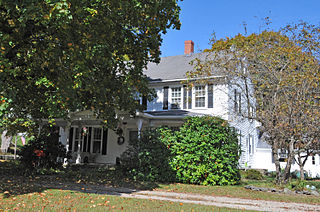
Ashlawn, also called the Joshua Perkins House, is a two-story, central-hall frame farmhouse dating from the 18th century in Hanover, Connecticut. The house's namesake is its first owner, Joshua Perkins, a farmer and son of the prominent Captain Matthew Perkins, a farmer and founding member of the Hanover Society. Ashlawn's main house has a five-bay front facade with pilasters supporting broken-base pediments. The inside has well-documented woodwork for its moldings and wainscotting. The house has integrated an older structure, likely a central-chimney structure built in the second quarter of the 18th century, as an ell.

Barratt Hall, also known as the Philip Barratt House, is a historic home located near Frederica, Kent County, Delaware. It dates to the mid-18th century, and is a two-story, three bay, center-hall plan brick dwelling in the Georgian-style. In 1784, Bishops Thomas Coke and Francis Asbury met in the house with Mrs. Miriam Barratt and eleven preachers. They held council here which ended in sending Freeborn Garrettson to summon preachers to the Christmas Conference in Baltimore, Maryland, at which the Methodist Church in America was organized. It was the home of Philip Barratt, who donated land and, together with Waitman Sipple, erected Barratt's Chapel in 1780.

Mathew H. Ritchey House, also known as Mansion House and Belle Starr House, is a historic home located in Newtonia, Newton County, Missouri. It was built about 1840, and is a two-story, brick dwelling with a two-story rear wing built using slave labor. The house rests on a sandstone block foundation and has a side-gabled roof. It features a one-story front portico and interior end chimneys. Also on the property is the contributing Ritchey family cemetery, outbuildings, and a well. During the American Civil War, the site saw fighting during both the First and Second Battles of Newtonia, which required its use as a hospital after the battles. It was listed on the National Register of Historic Places in 1978 and is a contributing property in the First Battle of Newtonia Historic District. The building was damaged by a tornado in 2008.























